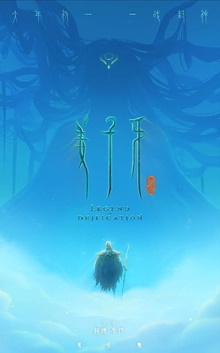This is the follow-up to the surprisingly good Chinese animated film Nezha and part of what they are calling the Fengshen Cinematic Universe. In truth, it doesn’t look like there is much connection between the two films save that they are set in a sort of mythological version of China. If anything this one is even more fantastic and, yes, it is just as good. The art looks amazing and more importantly has a single consistent style and there’s certainly no begrudging the soaring ambition of its story.
Following the great war at the end of the Shang Dynasty, Jiang Ziya the disciple of the Primeval Lord of Heaven, had been elevated to the top ranks of the gods due to successfully capturing the Nine-Tailed Demon Fox. It is believed that the Fox seduced the last Shang emperor and caused the war in the first place. However just as he is about to execute the Fox as ordered, he perceives a little girl inside the Fox and fails to carry out the execution. For this, he is stripped of his godly power and exiled to live among many demons. Accompanying him is a younger apprentice Shen Gongbao who watches over him. One day a young girl, Xiao Jiu, turns up in search of a map that she believes will lead her to place where her father waits for her. Ziya recognizes her as the girl he saw inside the Fox and indeed she has some physical characteristics that are similar to the Fox. Desperate to know who she is, he breaks his captivity to pursue her and in doing so uncovers secrets that will lead him to question the righteousness of the Heavens themselves.
As with Nezha, the setting and characters here may have been inspired by the classic Investiture of the Gods but the film takes such artistic license that the plot bears little resemblance to that of the novel. Not being familiar with the novel, I had a great deal of difficulty even understanding where this takes place as this is seemingly a version of China that is crammed full of demons, spirits and deities and where feats of magic are common. In fact, I don’t believe that there are any scenes with ordinary mortals at all. I wish the film included some exposition to explain this background but I suppose most Chinese audiences are presumed to be more or less familiar with the original work anyway. As such it took me a little while to get into the groove but once I did it worked fairly well as a standard adventure film with some predictable twists. The art is great, being improved mainly by being so much more consistent in style but also showing incredible boldness, the action flows well and the story looked set on culminating in the expected but still enjoyable climax of having Ziya turn against his master. Then that’s when the film surprises me yet again with just how far it is willing to go to overturn convention.
To have Ziya being less than satisfied with Heaven’s plans that involve sacrificing the innocent for the sake of the greater good is pretty par for the course but to have him openly defy Heaven is eyebrow-raising. But this film goes even further than that. Once he realizes the extent of Heaven’s hypocrisy and duplicity, he gains a power-up and visually changes to a form that can’t help but make me think of a Jesus-like figure. Add to that the moral judgment that any kind of good that would sacrifice the merest innocent is no good at all and this feels very much like championing Western individualist values over Eastern collectivist ones. It’s truly revolutionary and kind of eye-opening that this is acceptable in China now. It’s also intriguing how the art style includes designs that look like technology, so elements like the process of reincarnation seems to involve massive pieces of machinery doing the work behind the scenes or how Heaven itself seems to be full of technological devices. All this makes for fantastic and novel worldbuilding and says all sorts of good things about China being willing to give greater artistic license to works of pure imagination even when they contradict how these concepts and scenes are traditionally depicted.
In the end Jiang Ziya does pull back its punches slightly by asserting that there is a higher authority even above the so-called ultimate authority so overall order is maintained but I’m still amazed that it goes as far as it does. I also love that its story unflinchingly deals with real loss and death when mainstream Western animated films dance around them, even when the films are supposed to be watched by adults. And of course in terms of production values and sheer visual beauty, this film certainly stands up to the best of what the US is able to make. As with the previous film, this one ends with a teaser for the next project and it says a lot about how good these films now are that we’re actively looking forwards to it.
